MIGHTY NINETY
Chapter 1: Beginnings
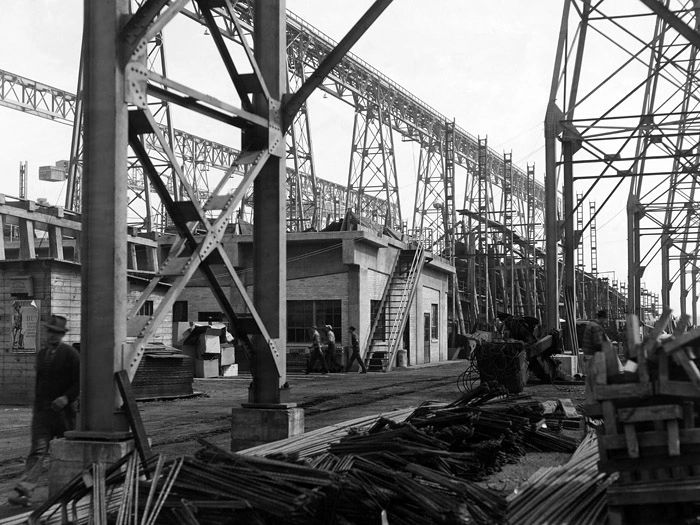
The ways at the Cramp Shipbuilding Company where USS Astoria CL-90 was built. This photo was taken in October 1941, less than one month after her keel was laid and before America became a belligerent in World War II. Note the Defense Bonds poster at far left, the 1941 precursor to War Bond posters.
-photo from NARA Records Group 19-LCM
11 September 1940
With American involvement in the Second World War becoming more and more imminent, the U.S. Navy placed an order for six additional Cleveland-class cruisers to be added to their Fiscal Year 1941 building program. Construction of these six cruisers, Navy hull numbers CL-89 through CL-94, was awarded to the revitalized Cramp Shipbuilding Company of Philadelphia, PA.
The six Cramp Clevelands kept with the tradition of naming cruisers after U.S. cities and were to be named:

Cramp employees working on the inner bottom of Hull 533 on 5 October 1941. Hull 533 was designated to become the Cleveland-class light cruiser CL-90 for the United States Navy.
-photo from NARA Records Group 19-LCM
6 September 1941
The keel of hull 533 was laid by the Cramp Shipbuilding Company, Philadelphia, PA. In the months that followed, this hull began to take on the sleek lines of a cruiser.
7 December 1941
Hull 533 was three months into its construction when the nation learned that U.S. military installations had been attacked by Imperial Japan on the island of Oahu, Territory of Hawaii, most notably at Pearl Harbor. In the days that followed, Japanese attacks were expanded to American, British, Dutch, and Australian interests across the Pacific. America became a nation at war.
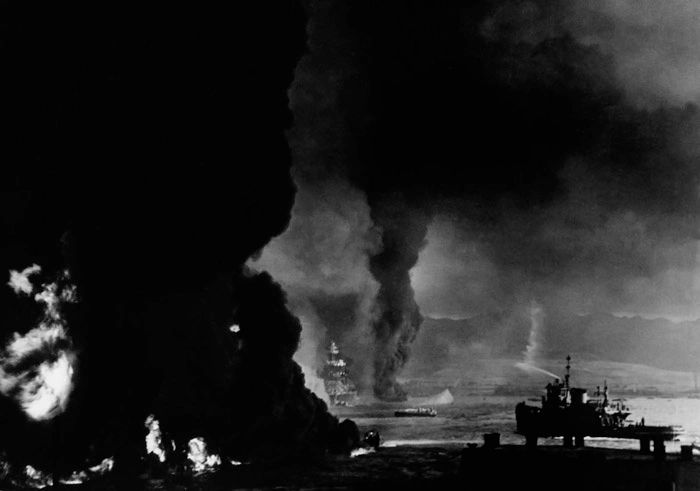
USS California BB-44 is engulfed in an inferno of smoke and flame at left, while at center Oklahoma BB-37 lies capsized next to Maryland BB-46 on battleship row. Harbor tug Nokomis YT-142 moves in to assist on the morning of 7 December 1941.
-U.S. Navy photo from Brent Jones collection
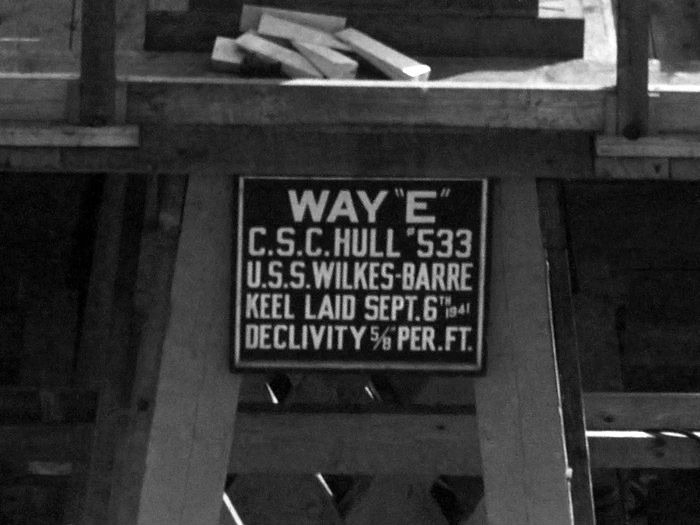
The sign for Way "E" at Cramp Shipbuilding Company in January 1942. Hull 533 is shown as USS Wilkes-Barre.
-photo from NARA Records Group 19-LCM
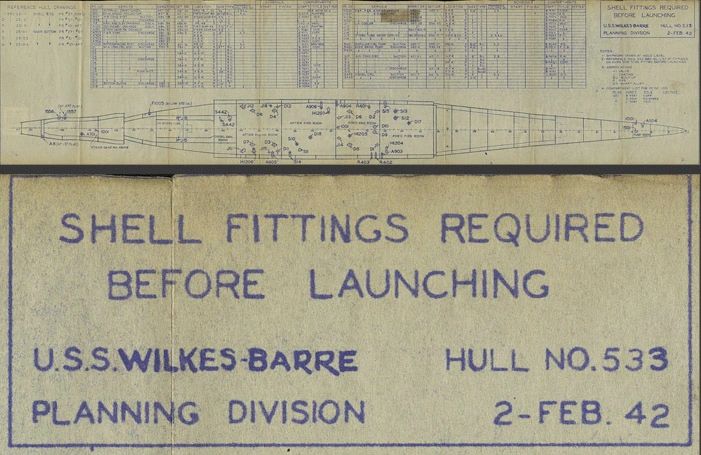
Original 1942 Hull 533 plans from Cramp Shipbuilding Company.
-from Brent Jones collection
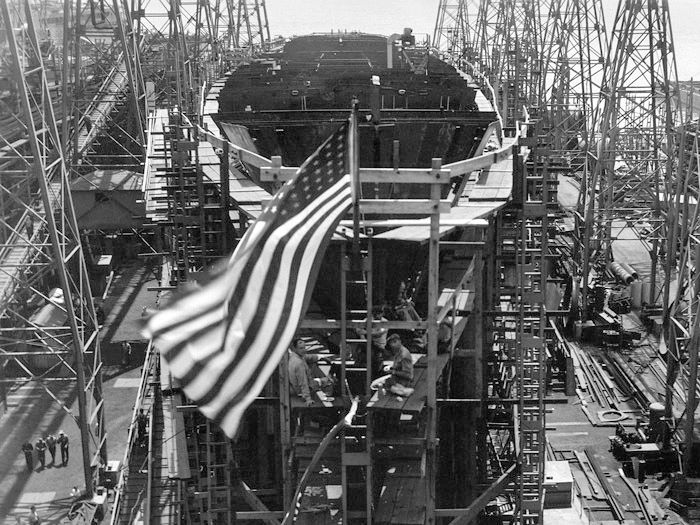
By July 1942, the hull of Wilkes-Barre has taken the shape of a cruiser.
-photo from NARA Records Group 19-LCM
7 August 1942
Eight months after declaring war, the United States launched its first offensive against Japan. First light brought the kickoff of a pivotal invasion of the strategic Solomon Islands of Guadalcanal, Florida, and Tulagi. Three U.S. heavy cruisers took the lead in preparatory shore bombardment. USS Vincennes CA-44, USS Quincy CA-39, and USS Astoria CA-34.

USS Vincennes CA-44 fires her forward main battery in misting rain at dawn on 7 August 1942. The outline of Guadalcanal is just visible in the early morning light, as is the ship's camouflage pattern. This image was taken from HMAS Australia.
-Royal Australian Navy photo from Brent Jones collection
8-9 August 1942
In night action off Guadalcanal near Savo Island, the U.S. Cruisers Vincennes, Quincy, and Astoria were all sunk by a Japanese force along with the Australian cruiser HMAS Canberra. Astoria CA-34, "Nasty Asty" to her crew, was hit at least 65 times by enemy shells. Her surviving crew worked through the night and morning to save their ship, but shortly after noon the next day, she gave in to overwhelming fires and slipped beneath the surface. Astoria was the last ship in the battle to sink.
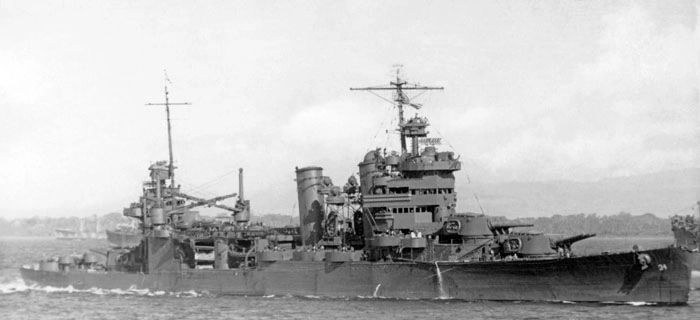
One of the last photos of USS Astoria CA-34, 7 August 1942. Within two days she would be in the depths of what came to be known as "Iron Bottom Sound."
-RAN photo from Brent Jones collection
For over two months the American public was not informed of the losses at Savo. Meanwhile work continued on the two Cleveland-class cruisers at Cramp, Miami CL-89 and Wilkes-Barre CL-90. Although Cramp was also busy building submarines and auxiliaries, the shipyard's capacity for cruisers was only two at a time; the keel-laying on Oklahoma City CL-91 had to wait until CL-89 was launched.
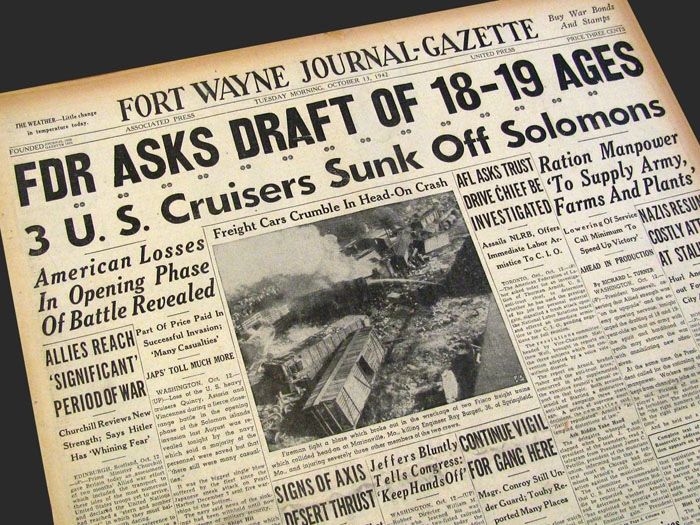
On 13 October 1942 the American public learned of the losses in the Battle of Savo Island. By that time American progress in the Guadalcanal campaign was deemed sufficient to lessen the impact of the three lost heavy cruisers.
-from Brent Jones collection
USS Astoria had been a proud ship, serving with distinction throughout her career. In the early days of World War II, she performed screen duty for American carriers during the battles of the Coral Sea and Midway, and she went down fighting at Guadalcanal. It was only fitting that the Navy would christen a new USS Astoriaalong with other cruisers lost early in the war.
In late October 1942, the hull of CL-90 was renamed from Wilkes-Barre to Astoria to commemorate the sacrifices of Nasty Asty and her crew. Other "vengeance ships" began to slide down the ways in an American Navy that would come to dwarf its pre-war predecessor in scale.
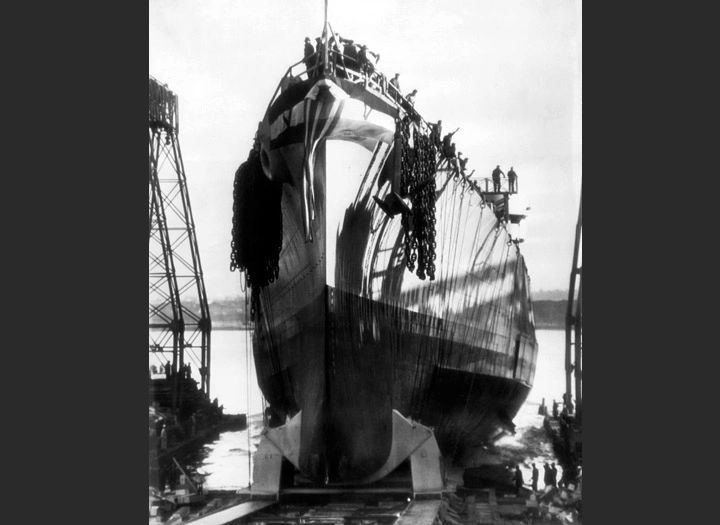
On 8 December 1942, one year to the day after the declaration of war on Imperial Japan, USS Miami became the first WWII cruiser launched by the Cramp Shipbuilding Company. In the next shipway, USS Astoria neared her own launch.
-photo from Brent Jones collection
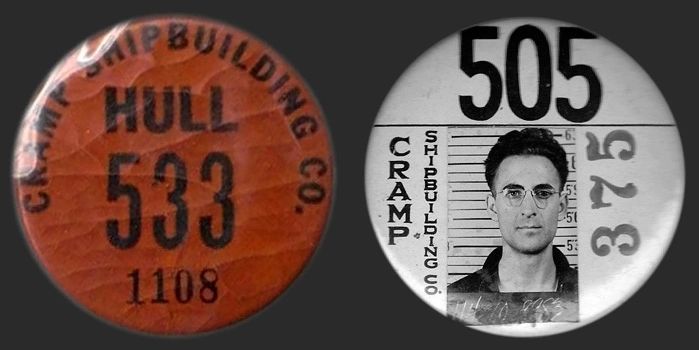
ID buttons worn by Cramp employees who built USS Astoria CL-90, Walter Mikus and Sal Indelicato.
-courtesy of Joe Mikus and Sal Indelicato
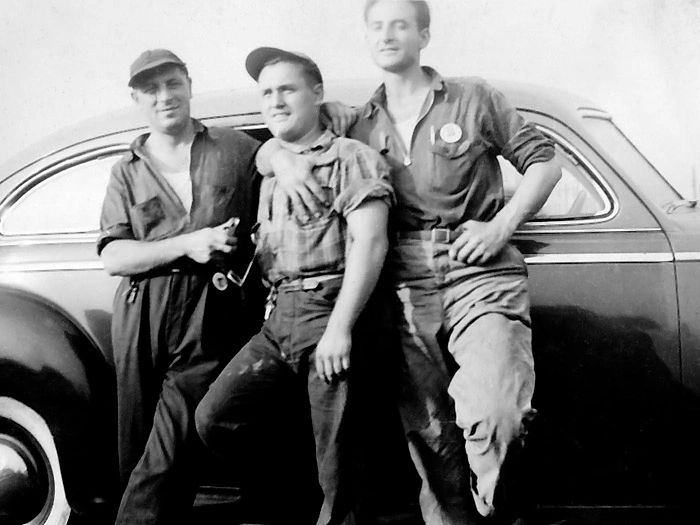
Sal Indelicato (at right) with buddies from Cramp Shipbuilding Company in 1943.
-photo courtesy of Sal Indelicato
6 March 1943
After 18 months of construction, the completed hull of Astoria was launched into the Delaware River. She was sponsored by Mrs. Peggy Lucas, wife of the editor of the Astorian-Budget newspaper and a direct descendant of John Jacob Astor.
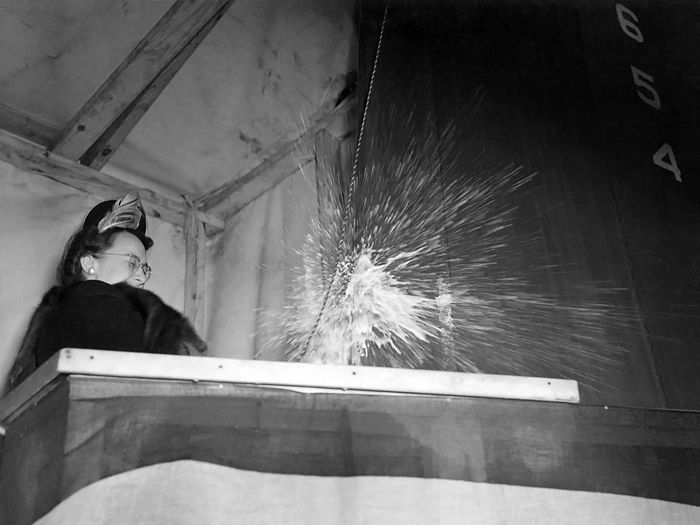
Ship sponsor Peggy Lucas breaks a champagne bottle across the bow of the new Astoria at Cramp Shipyard, 6 March 1943.
-photo from NARA Records Group 80-G
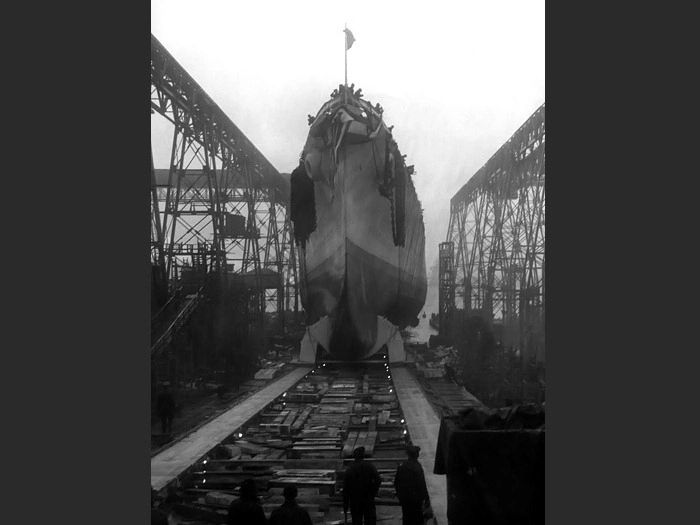
Cramp hull 533-Astoria slides down the way into the Delaware River, 6 March 1943.
-photo from NARA Records Group 80-G
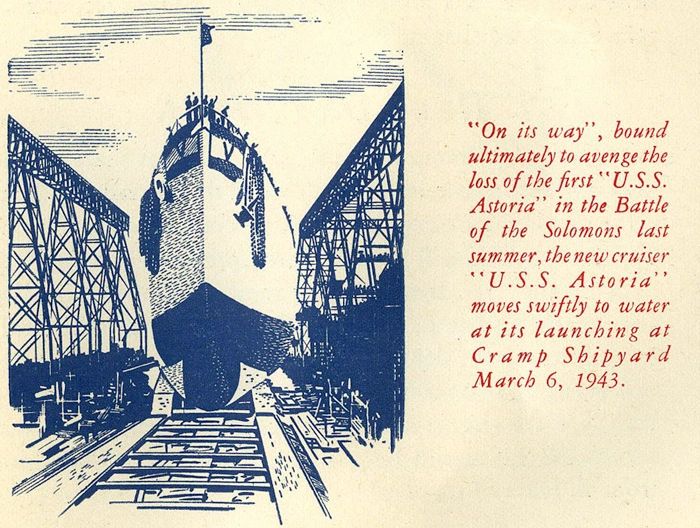
The launching of Astoria commemorated in a 1943 Cramp wartime publication.
-from Brent Jones collection
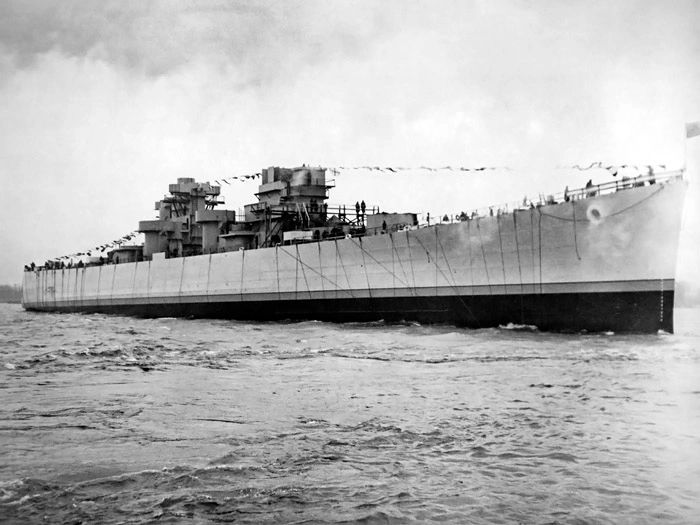
Astoria in the Delaware River shortly after launching. Note the absence of gun turrets, masts, and much of her superstructure.
-photo from NARA Records Group 80-G
Once in the water, construction shifted to finishing out Astoria's superstructure. She was still fourteen months from completion and commissioning. Other ships were being built in unprecedented numbers, including more Cleveland-class cruisers.
Across the river from Astoria at New York Ship, CL-103 was launched several months later with the reassigned name of Wilkes-Barre. Up at the Bethlehem Fore River Yard in Quincy, MA, Pasadena CL-65 and Springfield CL-66 were also nearing completion. These four Cleveland-class cruisers would ultimately serve together as Cruiser Division 17 throughout 1945.
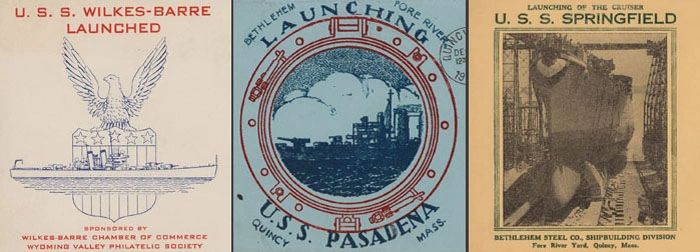
The launchings of future Cruiser Division 17 ships are commemorated on these philatelic envelopes.
-Brent Jones collection
Continue to CHAPTER 2: PLANKOWNERS

CLICK PHOTOS TO ADVANCE TO NEXT CHAPTER
BACK TO SHIP HISTORY
Sources:
Friedman,
Norman.
U.S. Cruisers: An Illustrated Design History.
Annapolis, MD: Naval Institute Press, 1984
Jones, Brent. Private document collection.
MIGHTY NINETY: USS ASTORIA CL-90 cruise book. Unk. publisher, 1946.
Mikus, Joe. Private artifact collection.
Schmitt, Ron and Indelicato, Sal. Private photo and artifact collections.
Schnipper, Herman. Private photo and document collection.
www.archives.gov National Archives and Records Administration WWII photo archive.

The ways at the Cramp Shipbuilding Company where USS Astoria CL-90 was built. This photo was taken in October 1941, less than one month after her keel was laid and before America became a belligerent in World War II. Note the Defense Bonds poster at far left, the 1941 precursor to War Bond posters.
-photo from NARA Records Group 19-LCM
11 September 1940
With American involvement in the Second World War becoming more and more imminent, the U.S. Navy placed an order for six additional Cleveland-class cruisers to be added to their Fiscal Year 1941 building program. Construction of these six cruisers, Navy hull numbers CL-89 through CL-94, was awarded to the revitalized Cramp Shipbuilding Company of Philadelphia, PA.
The six Cramp Clevelands kept with the tradition of naming cruisers after U.S. cities and were to be named:
| USS Miami CL-89 | USS Little Rock CL-92 |
| USS Wilkes-Barre CL-90 | USS Galveston CL-93 |
| USS Oklahoma City CL-91 | USS Youngstown CL-94 |

Cramp employees working on the inner bottom of Hull 533 on 5 October 1941. Hull 533 was designated to become the Cleveland-class light cruiser CL-90 for the United States Navy.
-photo from NARA Records Group 19-LCM
6 September 1941
The keel of hull 533 was laid by the Cramp Shipbuilding Company, Philadelphia, PA. In the months that followed, this hull began to take on the sleek lines of a cruiser.
7 December 1941
Hull 533 was three months into its construction when the nation learned that U.S. military installations had been attacked by Imperial Japan on the island of Oahu, Territory of Hawaii, most notably at Pearl Harbor. In the days that followed, Japanese attacks were expanded to American, British, Dutch, and Australian interests across the Pacific. America became a nation at war.

USS California BB-44 is engulfed in an inferno of smoke and flame at left, while at center Oklahoma BB-37 lies capsized next to Maryland BB-46 on battleship row. Harbor tug Nokomis YT-142 moves in to assist on the morning of 7 December 1941.
-U.S. Navy photo from Brent Jones collection

The sign for Way "E" at Cramp Shipbuilding Company in January 1942. Hull 533 is shown as USS Wilkes-Barre.
-photo from NARA Records Group 19-LCM

Original 1942 Hull 533 plans from Cramp Shipbuilding Company.
-from Brent Jones collection

By July 1942, the hull of Wilkes-Barre has taken the shape of a cruiser.
-photo from NARA Records Group 19-LCM
7 August 1942
Eight months after declaring war, the United States launched its first offensive against Japan. First light brought the kickoff of a pivotal invasion of the strategic Solomon Islands of Guadalcanal, Florida, and Tulagi. Three U.S. heavy cruisers took the lead in preparatory shore bombardment. USS Vincennes CA-44, USS Quincy CA-39, and USS Astoria CA-34.

USS Vincennes CA-44 fires her forward main battery in misting rain at dawn on 7 August 1942. The outline of Guadalcanal is just visible in the early morning light, as is the ship's camouflage pattern. This image was taken from HMAS Australia.
-Royal Australian Navy photo from Brent Jones collection
8-9 August 1942
In night action off Guadalcanal near Savo Island, the U.S. Cruisers Vincennes, Quincy, and Astoria were all sunk by a Japanese force along with the Australian cruiser HMAS Canberra. Astoria CA-34, "Nasty Asty" to her crew, was hit at least 65 times by enemy shells. Her surviving crew worked through the night and morning to save their ship, but shortly after noon the next day, she gave in to overwhelming fires and slipped beneath the surface. Astoria was the last ship in the battle to sink.

One of the last photos of USS Astoria CA-34, 7 August 1942. Within two days she would be in the depths of what came to be known as "Iron Bottom Sound."
-RAN photo from Brent Jones collection
For over two months the American public was not informed of the losses at Savo. Meanwhile work continued on the two Cleveland-class cruisers at Cramp, Miami CL-89 and Wilkes-Barre CL-90. Although Cramp was also busy building submarines and auxiliaries, the shipyard's capacity for cruisers was only two at a time; the keel-laying on Oklahoma City CL-91 had to wait until CL-89 was launched.

On 13 October 1942 the American public learned of the losses in the Battle of Savo Island. By that time American progress in the Guadalcanal campaign was deemed sufficient to lessen the impact of the three lost heavy cruisers.
-from Brent Jones collection
USS Astoria had been a proud ship, serving with distinction throughout her career. In the early days of World War II, she performed screen duty for American carriers during the battles of the Coral Sea and Midway, and she went down fighting at Guadalcanal. It was only fitting that the Navy would christen a new USS Astoriaalong with other cruisers lost early in the war.
In late October 1942, the hull of CL-90 was renamed from Wilkes-Barre to Astoria to commemorate the sacrifices of Nasty Asty and her crew. Other "vengeance ships" began to slide down the ways in an American Navy that would come to dwarf its pre-war predecessor in scale.

On 8 December 1942, one year to the day after the declaration of war on Imperial Japan, USS Miami became the first WWII cruiser launched by the Cramp Shipbuilding Company. In the next shipway, USS Astoria neared her own launch.
-photo from Brent Jones collection

ID buttons worn by Cramp employees who built USS Astoria CL-90, Walter Mikus and Sal Indelicato.
-courtesy of Joe Mikus and Sal Indelicato

Sal Indelicato (at right) with buddies from Cramp Shipbuilding Company in 1943.
-photo courtesy of Sal Indelicato
6 March 1943
After 18 months of construction, the completed hull of Astoria was launched into the Delaware River. She was sponsored by Mrs. Peggy Lucas, wife of the editor of the Astorian-Budget newspaper and a direct descendant of John Jacob Astor.

Ship sponsor Peggy Lucas breaks a champagne bottle across the bow of the new Astoria at Cramp Shipyard, 6 March 1943.
-photo from NARA Records Group 80-G

Cramp hull 533-Astoria slides down the way into the Delaware River, 6 March 1943.
-photo from NARA Records Group 80-G

The launching of Astoria commemorated in a 1943 Cramp wartime publication.
-from Brent Jones collection

Astoria in the Delaware River shortly after launching. Note the absence of gun turrets, masts, and much of her superstructure.
-photo from NARA Records Group 80-G
Once in the water, construction shifted to finishing out Astoria's superstructure. She was still fourteen months from completion and commissioning. Other ships were being built in unprecedented numbers, including more Cleveland-class cruisers.
Across the river from Astoria at New York Ship, CL-103 was launched several months later with the reassigned name of Wilkes-Barre. Up at the Bethlehem Fore River Yard in Quincy, MA, Pasadena CL-65 and Springfield CL-66 were also nearing completion. These four Cleveland-class cruisers would ultimately serve together as Cruiser Division 17 throughout 1945.

The launchings of future Cruiser Division 17 ships are commemorated on these philatelic envelopes.
-Brent Jones collection
Continue to CHAPTER 2: PLANKOWNERS

CLICK PHOTOS TO ADVANCE TO NEXT CHAPTER
BACK TO SHIP HISTORY
Sources:
Friedman,
Jones, Brent. Private document collection.
MIGHTY NINETY: USS ASTORIA CL-90 cruise book. Unk. publisher, 1946.
Mikus, Joe. Private artifact collection.
Schmitt, Ron and Indelicato, Sal. Private photo and artifact collections.
Schnipper, Herman. Private photo and document collection.
www.archives.gov National Archives and Records Administration WWII photo archive.
